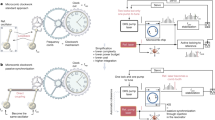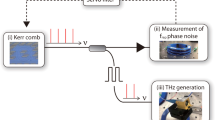Abstract
Optical frequency division via optical frequency combs has enabled a leap in microwave metrology, leading to noise performance never explored before. Extending this method to the millimetre-wave and terahertz-wave domains is of great interest. Dissipative Kerr solitons in integrated photonic chips offer the unique feature of delivering optical frequency combs with ultrahigh repetition rates from 10 GHz to 1 THz, making them relevant gears for performing optical frequency division in the millimetre-wave and terahertz-wave domains. We experimentally demonstrate the optical frequency division of an optically carried 3.6 THz reference down to 300 GHz through a dissipative Kerr soliton, photodetected with an ultrafast uni-travelling-carrier photodiode. A new measurement system, based on the characterization of a microwave reference phase locked to the 300 GHz signal under test, yields attosecond-level timing-noise sensitivity, overcoming conventional technical limitations. This work places dissipative Kerr solitons as a leading technology in the millimetre-wave and terahertz-wave field, promising breakthroughs in fundamental and civilian applications.
This is a preview of subscription content, access via your institution
Access options
Access Nature and 54 other Nature Portfolio journals
Get Nature+, our best-value online-access subscription
$29.99 / 30 days
cancel any time
Subscribe to this journal
Receive 12 print issues and online access
$209.00 per year
only $17.42 per issue
Buy this article
- Purchase on Springer Link
- Instant access to full article PDF
Prices may be subject to local taxes which are calculated during checkout




Similar content being viewed by others
Data availability
The data that support the findings of this study are available from the corresponding author upon reasonable request.
References
Nagatsuma, T. et al. Millimeter-wave and terahertz-wave applications enabled by photonics. IEEE J. Quantum Electron. 52, 0600912 (2015).
Koenig, S. et al. Wireless sub-THz communication system with high data rate. Nat. Photon 7, 977–981 (2013).
Dhillon, S. et al. The 2017 terahertz science and technology roadmap. J. Phys. D 50, 043001 (2017).
Dang, S., Amin, O., Shihada, B. & Alouini, M. S. What should 6G be? Nat. Electron. 3, 20–29 (2020).
Zhang, Z. et al. 6G wireless networks: vision, requirements, architecture, and key technologies. IEEE Veh. Technol. Mag. 14, 28–41 (2019).
Wang, C. et al. An on-chip fully electronic molecular clock based on sub-terahertz rotational spectroscopy. Nat. Electron. 1, 421–427 (2018).
De Graauw, T. et al. The Herschel-heterodyne instrument for the far-infrared (HIFI). Astron. Astrophys. 518, L6 (2010).
Brünken, S. et al. H2D+ observations give an age of at least one million years for a cloud core forming Sun-like stars. Nature 516, 219–221 (2014).
Nanni, E. A. et al. Terahertz-driven linear electron acceleration. Nat. Commun. 6, 8486 (2015).
Zhang, D. et al. Segmented terahertz electron accelerator and manipulator (STEAM). Nat. Photon. 12, 336–342 (2018).
Grajal, J. et al. Compact radar front-end for an imaging radar at 300 GHz. IEEE Trans. Terahertz Sci. Technol. 7, 268–273 (2017).
Appleby, R., Robertson, D. A. & Wikner, D. Millimeter wave imaging: a historical review. In Proc. Passive and Active Millimeter-Wave Imaging XX (eds Wikner, D. A. & Robertson, D. A.) 1018902 (SPIE, 2017).
Patole, S. M., Torlak, M., Wang, D. & Ali, M. Automotive radars: a review of signal processing techniques. IEEE Signal Process. Mag. 34, 22–35 (2017).
Matei, D. G. et al. 1.5 μm lasers with sub-10 mHz linewidth. Phys. Rev. Lett. 118, 263202 (2017).
Huntemann, N., Sanner, C., Lipphardt, B., Tamm, C. & Peik, E. Single-ion atomic clock with 3 × 10−18 systematic uncertainty. Phys. Rev. Lett. 116, 063001 (2016).
McGrew, W. et al. Atomic clock performance enabling geodesy below the centimetre level. Nature 564, 87–90 (2018).
Brewer, S. et al. 27Al+ quantum-logic clock with a systematic uncertainty below 10−18. Phys. Rev. Lett. 123, 033201 (2019).
Yao, X. S. & Maleki, L. Optoelectronic microwave oscillator. J. Opt. Soc. Am. B 13, 1725–1735 (1996).
Li, J., Yi, X., Lee, H., Diddams, S. A. & Vahala, K. J. Electro-optical frequency division and stable microwave synthesis. Science 345, 309–313 (2014).
Li, Y. et al. Low-noise millimeter-wave synthesis from a dual-wavelength fiber Brillouin cavity. Opt. Lett. 44, 359–362 (2019).
Fortier, T. M. et al. Generation of ultrastable microwaves via optical frequency division. Nat. Photon. 5, 425–429 (2011).
Li, J., Lee, H., Chen, T. & Vahala, K. J. Low-pump-power, low-phase-noise, and microwave to millimeter-wave repetition rate operation in microcombs. Phys. Rev. Lett. 109, 233901 (2012).
Liang, W. et al. High spectral purity Kerr frequency comb radio frequency photonic oscillator. Nat. Commun. 6, 7957 (2015).
Lucas, E. et al. Ultralow-noise photonic microwave synthesis using a soliton microcomb-based transfer oscillator. Nat. Commun. 11, 374 (2020).
Ishibashi, T., Muramoto, Y., Yoshimatsu, T. & Ito, H. Unitraveling-carrier photodiodes for terahertz applications. IEEE J. Sel. Top. Quantum Electron. 20, 79–88 (2014).
Wang, N., Cakmakyapan, S., Lin, Y. J., Javadi, H. & Jarrahi, M. Room-temperature heterodyne terahertz detection with quantum-level sensitivity. Nat. Astron. 3, 977–982 (2019).
Ummethala, S. et al. THz-to-optical conversion in wireless communications using an ultra-broadband plasmonic modulator. Nat. Photon.13, 519–524 (2019).
Xie, X. et al. Photonic microwave signals with zeptosecond-level absolute timing noise. Nat. Photon. 11, 44–47 (2017).
Nakamura, T. et al. Coherent optical clock down-conversion for microwave frequencies with 10−18 instability. Science 368, 889–892 (2020).
Fortier, T. et al. Optically referenced broadband electronic synthesizer with 15 digits of resolution. Laser Photon. Rev. 10, 780–790 (2016).
Kippenberg, T. J., Gaeta, A. L., Lipson, M. & Gorodetsky, M. L. Dissipative Kerr solitons in optical microresonators. Science 361, eaan8083 (2018).
Liu, J. et al. Photonic microwave generation in the X- and K-band using integrated soliton microcombs. Nat. Photon. 14, 486–491 (2020).
Wang, B., Yang, Z., Zhang, X. & Yi, X. Vernier frequency division with dual-microresonator solitons. Nat. Commun. 11, 3975 (2020).
Xu, X. et al. Broadband microwave frequency conversion based on an integrated optical micro-comb source. J. Lightwave Technol. 38, 332–338 (2019).
Spencer, D. T. et al. An optical-frequency synthesizer using integrated photonics. Nature 557, 81–85 (2018).
Zhang, S. et al. Terahertz wave generation using a soliton microcomb. Opt. Express 27, 35257–35266 (2019).
Tetsumoto, T. et al. 300 GHz wave generation based on a Kerr microresonator frequency comb stabilized to a low noise microwave reference. Opt. Lett. 45, 4377–4380 (2020).
Swann, W. C., Baumann, E., Giorgetta, F. R. & Newbury, N. R. Microwave generation with low residual phase noise from a femtosecond fiber laser with an intracavity electro-optic modulator. Opt. Express 19, 24387–24395 (2011).
Kuse, N. & Fermann, M. E. Electro-optic comb based real time ultra-high sensitivity phase noise measurement system for high frequency microwaves. Sci. Rep. 7, 2847 (2017).
Kuse, N., Briles, T. C., Papp, S. B. & Fermann, M. E. Control of Kerr-microresonator optical frequency comb by a dual-parallel Mach-Zehnder interferometer. Opt. Express 27, 3873–3883 (2019).
Stern, B., Ji, X., Okawachi, Y., Gaeta, A. L. & Lipson, M. Battery-operated integrated frequency comb generator. Nature 562, 401–405 (2018).
Lee, H. et al. Spiral resonators for on-chip laser frequency stabilization. Nat. Commun. 4, 2468 (2013).
Gundavarapu, S. et al. Sub-hertz fundamental linewidth photonic integrated Brillouin laser. Nat. Photon. 13, 60–67 (2019).
Danion, G. et al. Mode-hopping suppression in long Brillouin fiber laser with non-resonant pumping. Opt. Lett. 41, 2362–2365 (2016).
Rubiola, E., Salik, E., Huang, S., Yu, N. & Maleki, L. Photonic-delay technique for phase-noise measurement of microwave oscillators. J. Opt. Soc. Am. B 22, 987–997 (2005).
Acknowledgements
We thank N. Kuse and M. Yeo for their technical contribution at the early stage of this work and Y. Uehara for his help. We are very grateful to V. Rolland for proofreading of the manuscript.
Author information
Authors and Affiliations
Contributions
T.T. and A.R. conceived the ideas, built, implemented and operated the experimental setup, and wrote the manuscript. T.N. provided the UTC-PD and insightful contributions on millimetre-wave technology. M.E.F. contributed to the conception of the project and the analysis of the data. T.T. designed and G.N. and M.G. fabricated the SiN microresonator. All authors contributed to the review of the manuscript. A.R. initiated and supervised the project.
Corresponding author
Ethics declarations
Competing interests
The authors declare no competing interests.
Additional information
Peer review information Nature Photonics thanks the anonymous reviewers for their contribution to the peer review of this work.
Publisher’s note Springer Nature remains neutral with regard to jurisdictional claims in published maps and institutional affiliations.
Supplementary information
Supplementary Information
Supplementary Figs. 1–5, Sections 1–5.
Rights and permissions
About this article
Cite this article
Tetsumoto, T., Nagatsuma, T., Fermann, M.E. et al. Optically referenced 300 GHz millimetre-wave oscillator. Nat. Photon. 15, 516–522 (2021). https://doi.org/10.1038/s41566-021-00790-2
Received:
Accepted:
Published:
Issue Date:
DOI: https://doi.org/10.1038/s41566-021-00790-2
This article is cited by
-
Integrated optical frequency division for microwave and mmWave generation
Nature (2024)
-
All-optical frequency division on-chip using a single laser
Nature (2024)
-
Frequency-selective perovskite photodetector for anti-interference optical communications
Nature Communications (2024)
-
A wideband, high-resolution vector spectrum analyzer for integrated photonics
Light: Science & Applications (2024)
-
Sub-THz wireless transmission based on graphene-integrated optoelectronic mixer
Nature Communications (2023)



